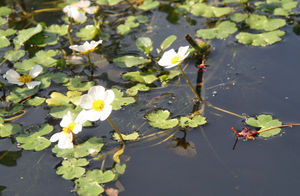Difference between revisions of "Common water-crowfoot"
From eagle-rock.org
| Line 19: | Line 19: | ||
== Chunks of information == | == Chunks of information == | ||
* This plant grows well in our pond. I found this plant in nature. The flowers are 7 to 20 mm. This plant adds oxygen to the water, an advantage when you have fish in your pond. Both the leaves under and on the water can be eaten fresh or dried. | * This plant grows well in our pond. I found this plant in nature. The flowers are 7 to 20 mm. This plant adds oxygen to the water, an advantage when you have fish in your pond. Both the leaves under and on the water can be eaten fresh or dried. | ||
| + | |||
| + | === Habitat == | ||
| + | Ponds, ditches, canals, streams, ponds, clay pits and dune ponds, sometimes in periodically flooded areas (annual in that case). | ||
== Gallery == | == Gallery == | ||
Revision as of 18:29, 21 May 2012
- Also called: white water-crowfoot
| Ranunculus aquatilis | |
|---|---|

| |
| Ranunculus aquatilis | |
| Scientific classification | |
| Kingdom: | Plantae |
| Order: | Ranunculales |
| Family: | Ranunculaceae |
| Subfamily: | Faboideae |
| Tribe: | Robinieae |
| Genus: | Ranunculus |
| Species: | R. aquatilis |
| Binomial name | |
| Ranunculus aquatilis | |
Chunks of information
- This plant grows well in our pond. I found this plant in nature. The flowers are 7 to 20 mm. This plant adds oxygen to the water, an advantage when you have fish in your pond. Both the leaves under and on the water can be eaten fresh or dried.
= Habitat
Ponds, ditches, canals, streams, ponds, clay pits and dune ponds, sometimes in periodically flooded areas (annual in that case).
Gallery
See also
External links
- Ranunculus aquatilis Wikipedia
